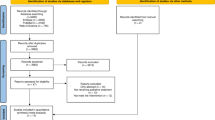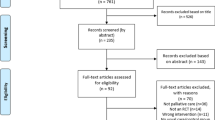Abstract
Purpose
The aim of this study is to explore the current literature examining the feasibility, safety, and efficacy of exercise interventions for individuals with myeloid leukemia.
Methods
A literature search was conducted in Ovid MEDLINE, AMED, Embase, PsycINFO, CINAHL, CENTRAL, and Web of Science using the terms “exercise” OR “physical activity” AND “myeloid leukemia.” Two reviewers performed duplicate title/abstract and full text screening of clinical trials comparing outcomes for people with myeloid leukemia participating in an exercise program. Initial searches yielded 149 articles. Two reviewers independently extracted data using piloted forms and assessed risk of bias using Cochrane’s tool. Data was extracted in relation to the study population, study intervention, comparator intervention, and outcomes assessed.
Results
Five trials were included in this review after 20 full-text articles were screened. Risk of bias was determined to be high in all five studies. Adherence rates were found to be low (<30 %) in all studies measuring this outcome. Positive improvements were found for fatigue, physical functioning, quality of life, and psychological distress for patients with AML; however, not all findings were significant. Leukocyte and BCR-ABL1 levels increased significantly post-exercise for participants with CML. Only one adverse event was reported.
Conclusions
Exercise interventions appear safe and feasible for individuals with AML. Not enough evidence was presented to comment on the feasibility of exercise programs for individuals with CML. Inconclusive evidence was found on the effectiveness of exercise to minimize side effects for participants with AML.


Similar content being viewed by others
References
National Cancer Institute. What you need to know about Leukemia (2013) Accessed October 7, 2014. Available at: http://www.cancer.gov/cancertopics/wyntk/leukemia
Sekers MA, Stone RM (2002) The challenge of acute myeloid leukemia in older patients. Curr Opin Oncol 14:24–30
Canadian Cancer Society. Acute myelogenous leukemia statistics ( 2014) Accessed October 7, 2014. Available at: http://www.cancer.ca/en/cancer-information/cancer-type/leukemia-acute-myelogenous-aml/statistics/?region=on
Canadian Cancer Society. Chronic myelogenous leukemia statistics (2014) Accessed October 7, 2014. Available at: http://www.cancer.ca/en/cancer-information/cancer-type/leukemia-chronic-myelogenous-cml/statistics/?region=bc
Canadian Cancer Society’s Advisory Committee on Cancer Statistics. Canadian Cancer Statistics (2014) Toronto, ON: Canadian Cancer Society; 2014
Alibhai SM, Leach M, Kowgier ME, Tomlinson GA, Brandwein JM, Minden MD (2007) Fatigue in older adults with acute myeloid leukemia: predictors and associations with quality of life and functional status. Leukemia 21(4):845–8
Canadian Cancer Society. Signs and symptoms of Leukemia (2014) Accessed October 7, 2014. Available at: http://www.cancer.ca/en/cancer-information/cancer-type/leukemia-acute-myelogenous-aml/signs-and-symptoms/?region=on
Casciato DA, Agha MF, Foon KA (2004) Acute leukemia and myelodysplastic sydromes. In: Casciato DA (ed) Manual of clinical oncology, 5th edn. Lippincott Williams & Wilkins, Philadelphia, pp 515–533
Katz LM, Howell JB, Doyle JJ, Stern LS, Rosenblatt LC, Piech CT et al (2006) Outcomes and charges of elderly patients with acute myeloid leukemia. Am J Hematol 81(11):850–857
Alibhai SM, O’Neill S, Fisher-Schlombs KF, Breunis H, Brandwein JM, Timilshina N, et al (2012) A clinical trial of supervised exercise for adult inpatients with acute myeloid leukemia (AML) undergoing induction chemotherapy. 26:1255–1261
Schmitz KH, Courneya KS, Matthews C, Demark-Wahnefried W, Galvao DA, Pinto BM et al (2010) American College of Sports Medicine roundtable on exercise guidelines for cancer survivors. Med Sci Sports Exerc 42:1409–1426
McNeely ML, Campbell KS, Rowe BH, Klassen TP, Mackey JR, Courneya KS (2006) Effects of exercise on breast cancer patients and survivors: a systematic review and meta-analysis. CMAJ 175:34–41
Thorsen L, Courneya KS, Stevinson C, Fossa SD (2008) A systematic review of physical activity in prostate cancer survivors: outcomes, prevalence, and determinants. Support Care Cancer 16:987–997
Adamson L, Quist M, Andersen C, Moller T, Herrstedt J, Kronbord D et al (2009) Effect of a multimodal high intensity exercise intervention in cancer patients undergoing chemotherapy: randomised controlled trial. BMJ 399:b3410
Courneya KS, Segal RJ, Mackay JR, Gelmon K, Reid RD, Friedenreich CM et al (2007) Effects of aerobic and resistance exercise in breast cancer patients receiving adjuvant chemotherapy: a multicenter randomized controlled trial. J Clin Oncol 25(28):4396–4404
Jarden M, Baadsgaard MT, Hovgaard DJ, Boesen E, Adamsen L (2009) A randomized trial on the effect of a multimodal intervention on physical capacity, functional performance and quality of life in adult patients undergoing allogenic SCT. Bone Marrow Transplant 43(9):725–737
Speck RM, Courneya KS, Masse LC, Duval S, Schmitz K (2010) An update of controlled physical activity trials in cancer survivors: a systematic review and meta-analysis. J Cancer Surviv 4:87–100
Wolin KKY, Ruiz JR, Tuchman H, Lucia A (2010) Exericse in adults and pediatric hematological cancer survivors: an intervention review. Leukemia 24(6):1113–1120
Higgins JPT, Thompson SG, Deeks JJ, Altman DGH (2008) Assessing risk of bias in included studies. In: Cochrane Handbook for Systematic Reviews of Interventions. Wiley-Blackwell, Chichester, pp 187–242
Reeves BC, Deeks JJ, Higgins JPT, Wells GA. Chapter 13: Including non-randomized studies. In: Higgins JPT, Green S (editors), Cochrane Handbook for Systematic Reviews of Interventions. Version 5.0.1 [updated September 2008]. The Cochrane Collaboration, 2008. Available from www.cochrane-handbook.org
Alibhai SM, O’Neill S, Fisher-Schlombs K, Breunis H, Timilshina N, Brandwein J et al (2014) A pilot phase II RCT of a home-based exercise intervention for survivors of AML. Support Care Cancer 22:881–889
Chang P, Yeur-Hur L, Shiow-Ching S, Lih-Ying L, Mei-Ling C, Youngsen Y et al (2008) Effects of a walking intervention on fatigue-related experiences of hospitalized acute myelogenous leukemia patients undergoing chemotherapy: a randomized controlled trial. J Pain Symptom Manage 35(5):524–534
Jonsson S, Olsson B, Jacobsson S, Palmqvist L, Ricksten A, Ekeland-Sjoberg K et al (2011) BCR-ABL1 transcript levels increase in peripheral blood but not in granulocytes after physical exercise in patients with chronic myeloid leukemia. Scand J Clin Lab Invest 71:7–11
Klepin H, Danhauer SC, Tooze JA, Stott K, Daley K, Vishnevsky T et al (2011) Exercise for older adult inpatients with acute myelogenous leukemia: a pilot study. J Geriatr Oncol 2:11–17
Orwin RG. Evaluating coding decisions (1994) In: Cooper H, Hedges LV, Eds. New York (NY): Russell Sage Foundation
Cramp F, Byron-Daniel J (2012) The effect of exercise on fatigue associated with cancer. Cochrane Db Syst Rev. 14(11). Available at: http://www.ncbi.nlm.nih.gov/pubmedhealth/PMH0013760
McNeely ML, Campbell K, Ospina M et al (2010) Exercise interventions for upper-limb dysfunction due to breast cancer treatment. Cochrane Database Syst Rev 16(6):CD005211. doi:10.1002/14651858.CD005211
Ahmed R, Thomas W, Yee D, Schmitz K (2006) Randomized controlled trial of weight training and lymphedema in breast cancer survivors. J Clin Oncol 24(18):2765–2772
Gardner JR, Livingston PM, Fraser SF (2014) Effects of exercise on treatment-related adverse effects of patients with prostate cancer receiving androgen-deprivation therapy: a systematic review. J Clin Oncol 32(4):335–346
Mustian KM, Griggs JJ, Morrow GR, McTiernan A, Roscoe JA, Bole CW et al (2006) Exercise and side effects among 749 patients during and after treatment for cancer: a university of Rochester cancer center community clinical oncology program study. Support Care Cancer 14(7):732–741
GW Cancer Institute. (2013, June 25). Cancer rehabilitation: a critical component of survivorship care [Webinar]. In GW Cancer Institute Webinar Series
Courneya KS, Katzmarzyk PT, Bacon E (2008) Physical activity and obesity in Canadian cancer survivors. Cancer 112(11):2475–82
Cheifetz O (2013) Clinicians commentary on Sing et al. Physiother Can 65(2):192–3
Orzech KM, Vivian J, Huebner Torres C, Armin J, Shaw SJ (2013) Diet and exercise adherence and practices among medicalled underserved patients with chronic disease: variation across four ethnic groups. 40(1):56–66
Davis AH (2007) Exercise adherence in patients with chronic obstructive pulmonary disease: an exploration of motivation and goals. Rehabil Nurs 32(3):104–110
Fernandez S, Franklin J, Amlani N, DeMilleville C, Lawson D, Smith J (2015) Physical activity and cancer: a study on the barriers and facilitators to exercise during cancer treatment. CONJ 42(1):37–42
Jones CJ, Rose DJ (2005) Strategies to increase exercise adherence in older adults. In: Physical Activity Instruction of Older Adults. ©. Human Kinetics. ISBN-13:9780736045131
Steele BG, Belza B, Cain KC, Coopersmith J, Lakshminarayan S, Howard J et al (2008) A randomized clinical trial of an activity and exercise adherence intervention in chronic pulmonary disease. Arch Phys Med Rehabil 89(3):404–412
Carek PJ, Laibstain SE, Carek SM (2011) Exercise for the treatment of depression and anxiety. Int J Psychiatry Med 41(1):15–28
Tordeurs D, Janne P, Appart A, Zdanowicz N, Reynaert C (2001) Effectiveness of physical exercise in psychiatry: a therapeutic approach. Encéphale 37(5):345–352
Jomar RT, de Souza Bispo VR (2014) The most common nursing diagnosis among adults/seniors hospitalized with cancer: integrative review. Ecancermedicalscience 8:462
Shapiro SL, Lopez AM, Schwartz GE et al (2001) Quality of life and breast cancer: relationship to psychosocial variables. J Clin Psychol 57(4):501–19
Wengstrom Y, Haggmark C, Strander H et al (2000) Perceived symptoms and quality of life in women with breast cancer receiving radiation therapy. Eur J Oncol Nurs 4(2):78–88
Gabriel H, Kindermann W (1997) The acute immune response to exercise: what does it mean? Int J Sports Med 18(Supp1):S28–S45
McCarthy DA, Perry JD, Melsom RD, Dale MM (1987) Leucocytosis induced by exercise. Br Med J 295:636
Gleeson M, Bishop NC (2005) The T cell and NK cell immune response to exercise. Ann Transplant 10:43–48
Steinsbekk A, Rygg L, Lisulo M, et al. (2012). Group based diabetes self-management education compared to routine treatment for people with type 2 diabetes mellitus. A systematic review with meta-analyses. BMC Health Serv Res 12:213. Available at: http://www.biomedicalcentral.com/1472–6963/12/213
Conflict of interest
The authors have no financial relationship with any sponsoring organization. The authors have full control of all primary data and agree to allow the journal to review the data if requested.
Author information
Authors and Affiliations
Corresponding author
Electronic supplementary material
Below is the link to the electronic supplementary material.
ESM 1
(DOCX 83 kb)
Rights and permissions
About this article
Cite this article
Smith-Turchyn, J., Richardson, J. A systematic review on the use of exercise interventions for individuals with myeloid leukemia. Support Care Cancer 23, 2435–2446 (2015). https://doi.org/10.1007/s00520-015-2752-3
Received:
Accepted:
Published:
Issue Date:
DOI: https://doi.org/10.1007/s00520-015-2752-3




